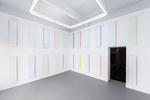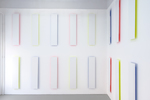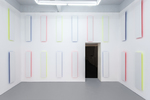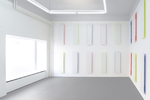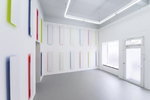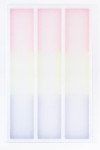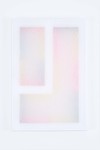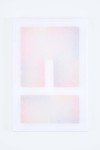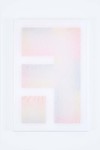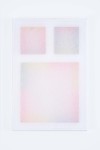Patric Sandri’s paintings are content and medium at the same time.
The Zurich based artist deals with perception and the aspect of looking. Using the mistakes of perceptual
apprehension has become more and more important in the way he generates ideas and works. The function of a three-dimensional object and its carrier is explored, often deconstructed and put into a new order. Light completes the paintings and is thematized by the different architectural parts of the works which are painted. The colours reflect and radiate on the background which is dipped in colored light. The front and the backsides of the works are equally important. The works have a sculptural character - but always remain committed to painting. Painting has it’s visual parameters, but couldn’t these be implemented in an alternative way through an intensified questioning of the role and perception of the artist as observer and vice versa?
Patric Sandri proposes a detachment from the rigor and age-long practice of painting in the form of panel painting that has been executed for centuries.
Shouldn’t the architecture of painting be questioned once more and revised in terms of implementing its media content more precisely?
Traditionally the viewer is confronted with a plane, mainly one surface, suggesting a pictorial space which is
attached to an object. The perception of this pictorial space results through detachment from actuality similar to a view out of the window. In this sense a painting presents itself in the exhibition room like an island in the ocean. Maybe the painting is able to create references within this space, but simultaneously it is trapped in an ongoing conflict between plane, object and space.
To lend honesty to the pictorial space and open the painterly window to the viewer, Sandri proposes a transformation of the pictorial tools as the actual space and environment. What is important is the perception of the site-specific image that should be viewed as a painting and not only as a collection of objects within the three-dimensional space. Rather, the scene in the actual room should be perceived as an image with depth and volume. The image shall be experienced through a heightened intensity by the participant, movement within the space becomes a tool for painting whereby the image and perspective constantly change. Similar to a stage, the space or environment now serves as an image-carrier, the composition as the plane, the matter as bodies, the light as a source. The pictorial space as actual space can visualize the paintings components by giving immediacy and authenticity without losing its materiality and visual message. With the participant involved, the perception within the painting becomes essential, connected directly with the reality of human experience.
Bei dem in Zürich lebenden Künstler Patric Sandri ist Malerei, Medium und Inhalt zugleich.
Er arbeitet mit der Wahrnehmung an sich, insbesondere dem Aspekt des Sehens. Fehler und Widersprüche in der Wahrnehmungsauffassung sind zentrale Momente, die Sandris Bildideen und Kompositionen beeinflussen. Wie schon Farbe und Bildträger wird auch das Licht aus den vermeintlichen Verbindlichkeiten der Malerei gelöst und selbst thematisiert. Vorder- und Rückseite werden gleichermassen zum Bildinhalt. Das Bild nimmt einen skulpturalen Charakter an – und bleibt dabei dennoch stets der Malerei verpflichtet.
Malerei hat ihre visuellen Parameter, doch können diese nicht anders umgesetzt werden?
Auch durch eine Aufforderung an die Künstler den Betrachter im Gemälde zu involvieren?
Sollte die Architektur der Malerei nicht doch noch einmal auf ihre Möglichkeiten und Konditionen überprüft und einer Revision auf eine präzisierte Umsetzung ihres medialen Inhalts unterzogen werden?
Normalerweise präsentiert sich das klassische Gemälde als Insel im Ausstellungsraum. Es schafft darin zwar Bezugspunkte, ist aber in einem fortwährenden Konflikt zwischen Fläche, Objekt und Raum.
So wird der Betrachter einer Fläche, welche einen Bildraum suggeriert gegenüber gestellt, gleich eines Blickes aus dem Fenster.
Mit der Verlagerung des Gemäldes in den Raum wird der Umraum ein Teil der perspektivischen Komposition. In Kombination mit der gegebenen Architektur und den Lichtverhältnissen ergibt sich daraus ein spezifisches Bild. Vielmehr soll das Bild als Tatsächliches in seiner Flächigkeit als auch Tiefe im Raum erlebt werden und die Räumlichkeit in seinem Volumen.
Die Arbeit wird in einer gesteigerten Intensität vom Betrachter erfahren, welcher durch seine eigene Bewegung im Raum das Bild verfollständigt: Bildausschnitt und Perspektive werden durch seine subjektivierte Wahrnehmung gesteuert, das Zentrum wechselnd positioniert. Gleich einer Bühne dient der Raum und das Umfeld nun als Bildträger, die Komposition als Fläche, die Masse als Körper, das Licht als Quelle, die Farbe als Licht. Der Bildraum als realer Raum vermag die Bestandteile der Malerei einer Direktheit und Echtheit einzufangen, mit einer Inklusion des Betrachters ohne dabei ihre Materialität und visuelle Botschaft abzulegen. Das Bild und dessen Wahrnehmung wird essentiell und mit der Realität des menschlichen Erlebens verknüpft.
While we look not at the things which are seen, but at the things which are not seen: for the things which are seen are temporal; but the things which are not seen are eternal.
The Second Letter of St. Paul to the Corinthians - Chapter 4
On this sunny Sunday this sentence from an epistle of St. Paul haunted my mind. On the one hand it could be because I randomly get roped in a children‘s choir concert and on the other hand, because I had to think about Patric Sandri’ s paintings. And not without good reason, because Patric’s paintings are not easy to grasp. We are not able to classify these easily in familiar art systems.
His color palette is the three basic colors red, yellow and blue. But don’t panic, it is not about the monumental absoluteness of monochrome primary colors. In white wall objects at Å+, he organizes the colors that way that these can only be perceived indirectly as intangible, colored light. Like in pointillist paintings, the pure colors created separately mingle with each other. So Sandri is able to play with the entire color spectrum of light as a material. Both Isaac Newton and Johann Wolfgang von Goethe would have enjoyed this work since it plays virtuously with the physical properties of colors and with the physical and psychic perceptual systems. But this is all accessories. Sandri’ work is not about the display of optical phenomena, but about the creation of poetic spaces in which colored light brings the white installation and thus the entire room to vibrate. An accessible painting.
Uns, die wir nicht auf das Sichtbare starren, sondern nach dem Unsichtbaren ausblicken; denn das Sichtbare ist vergänglich, das Unsichtbare ist ewig.
Paulus 2. Brief an die Korinther - Kapitel 4
Dass mir an diesem sonnigen Sonntag dieser Satz aus einer Epistel vom Paulus im Kopf herumspukt, kann (natürlich) zum einen an dem Kinderchorkonzert mit Gottesdienst liegen, in den ich wie zufällig hineingeraten bin, und zum anderen daran, dass ich die ganze Zeit an die Malerei von Patric Sandri denken musste. Und es kommt nicht von ungefähr, denn Patrics Malerei ist nicht einfach zu fassen, sie kann man nicht einfach wegsortieren in wohlvertraute Ordnungssysteme.
Seine Farbpalette sind die drei Grundfarben Rot, Gelb und Blau. Doch keine Angst, es geht ihm nicht um die monumentale Ab-so-lut-heit monochromer Primärfarben. In weißen Wandbjekten bei Å+ organisiert er die Farben so elegant, dass sie nur indirekt wahrnehmbar werden und so als immaterielles, farbiges Licht ihr Spiel treiben können. Wie in einem pointilistischen Bild mischen sich die hier separat angelegten reinen Farben miteinander. Simultanfarben vervielfältigen das Farbangebot zusätzlich, so steht ihm das ganze Farbspektrum des Lichts als Material zur Verfügung. Sowohl Isaac Newton als auch Johann Wolfgang von Goethe hätten an dieser Arbeit Freude gehabt, spielt sie doch virtuos sowohl mit der physikalischen Eigenschaften der Farben als auch mit den physischen und psychischen Wahrnehmungsapparaten des Menschen. Aber das ist alles nur Beiwerk, geht es hier ja nicht um Zurschaustellung optischer Phänomene, sondern um die Erschaffung poetischer Räume, in denen farbiges Licht die weiße Installation und damit den ganzen Raum zum Schwingen bringt. Raumgreifende begehbare Malerei.
Patrick Huber
As a whirling episode of the confused road at will quieted down, attention quested for challenge no more, but settled content on an unusual flamboyant red patch on the whipping hilltops of the steep ridge in west. Now even superior to these burning dunes my presence was soon to be vividly debated, upon which a swift series of cold summers ensued.
(...)
Muted the shine, only faint spasms of lightning saving the endless horizons from the pale oceans beneath them. Yet a silent storm of red fire found therein an excuse to branch out in a sun dried mind its heavy strings of myth, exhausted by situations unknown. But this is and will not be a part of me, this is you and you alone from now. I left you alone for this, and the weight of no cross will burden my back.
I told you that islands stretch to break the veil, and that blue will give in to its curling slides. When the time is right you’ll name it the hill where the doctors tarragon fields grow too, as you might know your outfit of predictions fits snug.
So a road or a journal might nimbly maneuver on, but the salvation of their picture is from whom to expect? Virtualty filter or the cage of a bony skull, amber casts shimmered despite their heritage then as now, I am only here to reflect.
Rasmus Kjelsrud
1 Untangled those years might be from ties to our now, but that’s questions to which I’d rather not subscribe. We shall now go back from mid-August to a certain afternoon some other year.

